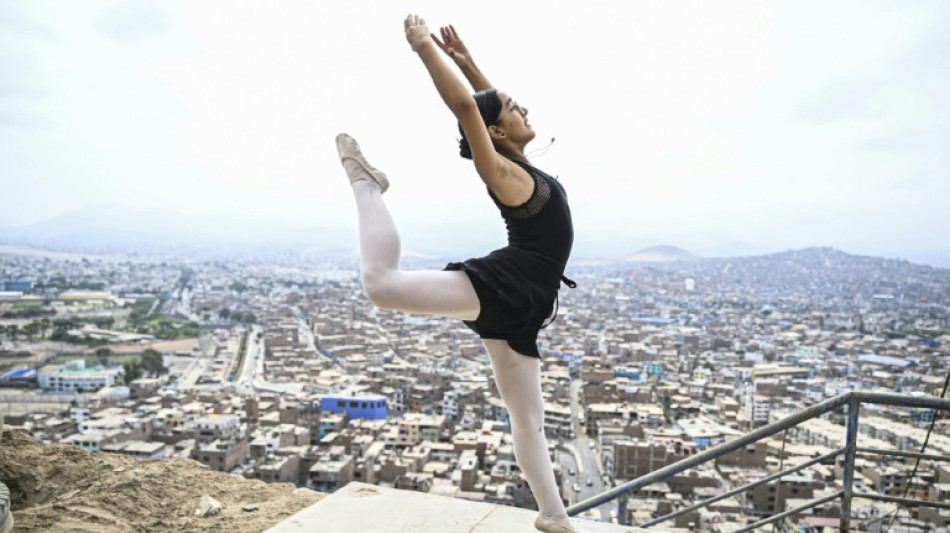
-
 'Sport will have the last word' as WRC title goes down to the wire in Japan
'Sport will have the last word' as WRC title goes down to the wire in Japan
-
Western powers move to censure Iran at UN nuclear meet

-
 US envoy presses Israel-Hezbollah truce bid in Lebanon visit
US envoy presses Israel-Hezbollah truce bid in Lebanon visit
-
'No controversy' around Alldritt exclusion for Argentina Test

-
 Stock markets gain, dollar higher before Nvidia earnings
Stock markets gain, dollar higher before Nvidia earnings
-
New WHO financing mechanism put to the test

-
 Besigye kidnapping: Uganda president's doctor turned rival
Besigye kidnapping: Uganda president's doctor turned rival
-
Star K-pop producer of NewJeans quits after legal spat with BTS agency

-
 'Eternal' Nadal leaves legacy as he retires from tennis
'Eternal' Nadal leaves legacy as he retires from tennis
-
Vieira takes over at struggling Gerona

-
 Australia's Kerevi banned for Morgan tackle
Australia's Kerevi banned for Morgan tackle
-
Bellamy defies 'lunatic' reputation to inspire Wales revival

-
 Kremlin says US 'doing everything' to prolong 'war' in Ukraine
Kremlin says US 'doing everything' to prolong 'war' in Ukraine
-
Magritte painting nets auction record of $121 million

-
 Markets fluctuate as traders weigh geopolitical tensions
Markets fluctuate as traders weigh geopolitical tensions
-
N. Korea's latest weapon? Bombarding South with noise

-
 'Kidnapped' Uganda opposition figure Besigye to appear at military court: lawyer
'Kidnapped' Uganda opposition figure Besigye to appear at military court: lawyer
-
Asian markets fluctuate as traders weigh geopolitical tensions

-
 'An inauspicious day': the landmines ruining Myanmar lives
'An inauspicious day': the landmines ruining Myanmar lives
-
UN to vote again on Gaza ceasefire, US plans unclear

-
 Japan's manga powerhouse 'Dragon Ball' turns 40
Japan's manga powerhouse 'Dragon Ball' turns 40
-
Japanese, Koreans bottom of global love life survey

-
 Son blames 'mistakes' after South Korea held by Palestine in qualifier
Son blames 'mistakes' after South Korea held by Palestine in qualifier
-
Japan ramps up tech ambitions with $65 bn for AI, chips

-
 Lights, action, melodrama! Silent films get new reel at London haven
Lights, action, melodrama! Silent films get new reel at London haven
-
Myanmar led world in landmine victims in 2023: monitor

-
 ICC to sentence Timbuktu war criminal
ICC to sentence Timbuktu war criminal
-
Ugandan opposition figure Besigye 'kidnapped', says wife

-
 Australia's Jason Day eyes more major glory after resurgence
Australia's Jason Day eyes more major glory after resurgence
-
Machu Picchu security boosted after visitors spread human ashes

-
 Popovic hails Australia character in 'crazy' World Cup qualifier
Popovic hails Australia character in 'crazy' World Cup qualifier
-
Taliban govt clearing 'un-Islamic' books from Afghanistan shelves

-
 Argentina beat Peru as Uruguay hold Brazil
Argentina beat Peru as Uruguay hold Brazil
-
Asian markets struggle as traders weigh geopolitical tensions

-
 Tatum stars as Celtics end Cavaliers unbeaten start
Tatum stars as Celtics end Cavaliers unbeaten start
-
Hurting India under pressure in blockbuster five-Test Australia series

-
 'They killed her dream': Israel strike leaves woman footballer in coma
'They killed her dream': Israel strike leaves woman footballer in coma
-
Iraq holds its first census in nearly 40 years

-
 Iraqis face tough homecoming a decade after IS rampage
Iraqis face tough homecoming a decade after IS rampage
-
Russian net tightens around last civilians left in eastern Ukraine

-
 Olympic champion Tebogo aims to inspire next generation of African athletes
Olympic champion Tebogo aims to inspire next generation of African athletes
-
Valencia on target as ten-man Ecuador upset Colombia

-
 'Rust' to premiere three years after on-set shooting
'Rust' to premiere three years after on-set shooting
-
Strike at French cognac maker Hennessy over measures in China spat

-
 Xi, Lula meet in Brasilia to 'enhance ties'
Xi, Lula meet in Brasilia to 'enhance ties'
-
SpaceX fails to repeat Starship booster catch, as Trump watches on

-
 'I have left a legacy': Nadal retires from tennis
'I have left a legacy': Nadal retires from tennis
-
US recognizes Venezuela opposition's Gonzalez Urrutia as 'president-elect'

-
 European powers, US seek to censure Iran at UN nuclear watchdog board
European powers, US seek to censure Iran at UN nuclear watchdog board
-
UNAIDS chief says husband, Ugandan opposition figure Besigye, 'kidnapped'


At a ballet in Lima shantytown, dancers - and self-esteem - soar
On a barren shantytown hill in Lima, a group of girls in white leggings gamely tiptoe around a rocky, dusty path. "And onnnne, twoooo, threee, fourrr", hums the ballet instructor whose day job is selling trash.
It's not likely any of her students will make it as a professional dancer, says Maria del Carmen Silva, or La Miss, as her students call her -- slang for teacher here.
Today, the teacher on the hill is more interested in healing than in the talent of her little "fairies."
Silva started classical dance at the age of 12, danced until she was 33 and today, at 58, she is leading an initiative to improve the lives of poor girls and teens through ballet -- long associated with a demanding (thin and white) aesthetic.
We had to be "thin, with long limbs, a small head and extremely flexible," recalls the former dancer with the national ballets of Peru and of neighboring Chile.
Silva, who is fair haired and has light eyes and a comfortable life, began volunteering in 2010 at a public school in the very poor coastal district of Chorrillos.
There she met the girls of San Genaro II, a settlement 300 meters above the level of the Pacific where in the last four decades some 500 families have settled in wooden houses with corrugated metal or zinc roofs.
- Rehearsing on the hill -
An endless number of stairs zigzag up the hills above Chorrillos, where the poor live.
Up here, there is no drinking water, and locals are supplied by tanker trucks or public wells.
Most people in the neighborhood eke out a living in the informal sector which in all of Peru reaches 75 percent of the working population, the highest rate after Bolivia, according to the International Labor Organization.
Silva confesses, half ashamed, that she came to school looking for a typical dancer, but she found girls with "short legs, flat feet or without much instep."
Sadly, above all, so many could barely muster a smile, when their everyday concerns were so pressing.
"Some of the girls have their dads in jail; others have been raped or mistreated by their parents; and some have told me: my dad beats my mom," she notes sadly.
"I am from a different economic class, so I didn't even realize that they were leaving because they couldn't afford the clothes; because they don't even have water and sometimes not even anything to eat," she says.
That's when she said she had a mental breakthrough.
"I told myself: forget about that perfect dancer, that perfect prototype, and reach out to the human being."
Now she organizes some rehearsals on the hill, despite the fact that her knees already suffer from the bustle between San Genaro II, the school, and the small school that she runs in a religious complex in Miraflores, one of Lima's more affluent districts.
- 'A different person' -
In that place, girls from "both economic situations" sometimes mix and it is a collection point for donations and for the cardboard, paper and bottles that the Silva ballet recycles to raise funds for costumes.
But only a few of those who attend the Silva ballet, she points out, realize the world of dirt and poverty from which her "fairies and princesses" emerge.
"Balance, balance, 'leap,' and up and two," she croons as she guides nine schoolgirls on a busy thoroughfare.
"I try to bring beauty where everything seems ugly, a drop of light where everything is black," says Silva pointing to the group with a grimace: "Despite the dirt from home they already want to be clean, they have their hair well combed, now they don't walk with their eyes looking at the ground.
She firmly believes that her ballet heals self-esteem.
"I didn't consider myself pretty. I was very shy, didn't say anything and now I can express myself," confirms 20-year-old Maria Cielo Cardenas.
"In ballet I am a different person, I feel like a princess, especially when we have performances and we put on costumes and crowns," she says. In January she and her partner Kerly Vera, 19, won a scholarship to study dance in Barcelona.
L.Adams--AT
